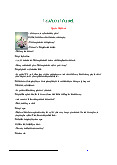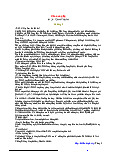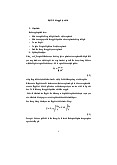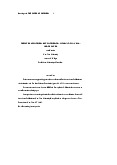






Preview text:
Glossary Project Management Terms and Definitions Course 1 A
Agile: A project management approach in which project phases overlap and tasks are completed in iterations
Authority: Refers to one's ability to make decisions for the project that impact the organization B
Barrier: Something that can get in the way of project progress
Buzzword: A word or phrase that is popular for a period of time or in a particular industry C
C-Suite: All the “chief” level officers in an organization
Change agent: A person from inside an organization who helps the organization
transform by focusing on improving organizational effectiveness and development
Change management: The process of delivering a completed project and getting people to adopt it
Classic structure: An organizational structure with a traditional, top-down reporting hierarchy
Closing: The phase at the end of a project during which team members' work is
celebrated and how the project went is evaluated
Contract work: Work done for a company by non-employees on a project-by- project basis
Corporate governance: The framework by which an organization achieves its goals and objectives
Cross-functional team: Team members who have different skill sets and may
even work in different departments but are all working towards the successful completion of a project
Culture mapping: A tool that can illustrate a company’s culture and how the
company’s values, norms, and employee behavior may be affected by change D
Delegation: Assigning tasks to individuals or resources who can best complete the work
Deliverable: A specific task or outcome
DMAIC: A strategy for process improvement; refers to the five phases in the Lean
Six Sigma approach: define, measure, analyze, improve, and control E
Effective communication: Refers to being transparent, upfront with plans and
ideas, and making information available
Escalation paths: Refers to the courses for communicating risks to the right people at the right time
Executing: Completing the tasks necessary to achieve the project goals F
Feedback mechanism: A tool that can capture input from stakeholders, such as a survey
Floating task: A task for which a change in its delivery would not affect the
project's overall success or impact its timeline
Flowchart: A tool that can visualize a project’s development process
Functional manager: The leader of a department in a functional (Classic) organization
Functional organizations: An organization divided into departments based on
function; also called a Classic organization G
Governance: The management framework within which decisions are made and
accountability and responsibility are determined I
Influencing without authority: Refers to a project manager’s ability to guide
teammates to complete their assigned work without acting as their direct managers
Initiation: The project phase that is the launchpad for the entire project; project
goals, deliverables, resources, budget, and people are identified at this stage
Internship: A short-term way to get hands-on experience in an industry
Interpersonal skills: The behaviors used to interact with others; skills than can
help one influence without authority, including communication, negotiation, conflict
mediation, and understanding motivations
Iterative: Refers to phases and tasks that overlap or happen at the same time that
other tasks are being worked on K
Kanban: An Agile approach and a tool that provides visual feedback about the
status of the work in progress through the use of Kanban boards or charts. L
Lean: A methodology in which the main principle is the removal of waste within an operation
Lean Six Sigma: A combination of two “parent” project management
methodologies: Lean and Six Sigma; used for projects that have goals to save
money, improve quality, and move through processes quickly
Linear: A project structure in which the previous phase or task has to be completed before the next can start M
Matrix structure: A hybrid organizational structure that is like a grid; includes
direct higher-ups to report to, as well as stakeholders from other departments or programs
Mission: Clarifies what the “what,” “who,” and “why” of the organization O
Organizational culture: Employees’ shared values and the organization’s values,
mission, history, and so on; a company’s personality
Organizational structure: The way a company or organization is arranged
Ownership: When people feel like they are empowered to take responsibility for
the successful completion of their tasks P
Planning: Making use of productivity tools and creating processes; creating and
maintaining plans, timelines, schedules, and other forms of documentation to track project completion
Program manager: A project manager who manages multiple projects for specific products, teams, or programs
Project: A unique endeavor which usually includes a set of unique deliverables; a
series of tasks that need to be completed to reach a desired outcome
Project governance: The framework for how project decisions are made
Project life cycle: The basic structure for a project; consists of four different
phases: initiate the project, make a plan, execute and complete tasks, and close the project
Project management: The application of knowledge, skills, tools, and techniques
to project activities to meet the project requirements
Project management methodology: A set of guiding principles and processes for
owning a project throughout its life cycle
Project management office: An internal group at a company that defines and
maintains project management standards across the organization
Project manager: Individual who shepherds projects from start to finish and
serves as a guide for their team, using their impeccable organizational and
interpersonal skills every step of the way
Project task: An activity that needs to be accomplished within a set period of time
by the project manager, the project team, or the stakeholder R
Reporting chart: A diagram showing the relationships among people and groups
within the organization and who each person or group reports to
Resource availability: Knowing how to access the people, equipment, and budget needed for a project
Resources: Anything needed to complete a project, such as people, equipment,
software programs, vendors, and physical space or locations
Retrospective: A workshop or meeting with the project team to note best
practices and learn how to manage a project more effectively the next time
Risk: A potential event which can occur and have an impact on a project S
Scrum: An Agile framework that focuses on developing complex projects through
collaboration and an iterative process. Work is completed by small, cross-functional
teams led by a Scrum Master and is divided into short Sprints with a set list of deliverables.
Six Sigma: A methodology used to reduce variations by ensuring that quality
processes are followed every time
Sprint: A phase in the Agile project management approach which has a defined
duration with a set list of deliverables
Stakeholder: People who are interested in and affected by the project’s completion and success
Steering committees: A group that decides on the priorities of an organization
and manages the general course of its operations T
Transferable skill: An ability that can be used in many different jobs and career paths U
Urgency: Getting team members to understand that the project is important and to
identify what actions need to be taken to move the project along V
Values: Principles that describe how employees are expected to behave W
Waterfall: A project management methodology that refers to the sequential ordering of phases




